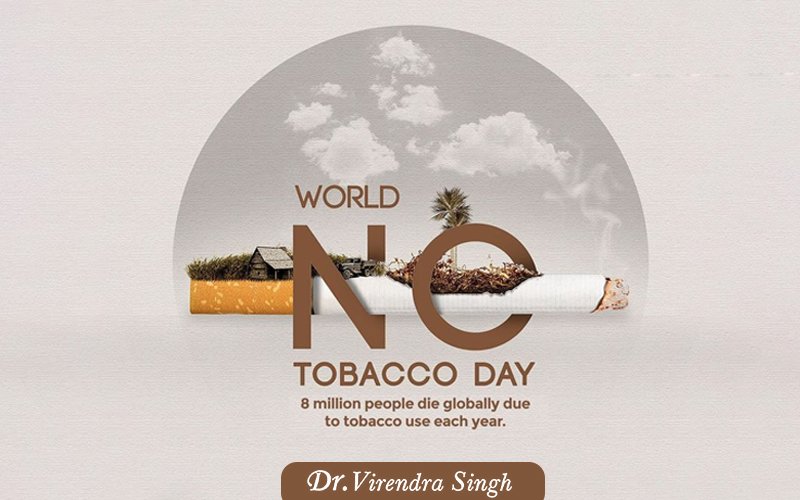
Every year on May 31, the World Health Organization (WHO) holds World No Tobacco Day. The goal of this day is to spread awareness about the risks of tobacco use and how we can make the world tobacco-free. Every year, around 6 million people die from tobacco-related ailments, and that number is forecast to increase to over 8 million by 2030. The Sustainable Development Agenda focuses on decreasing deaths from noninfectious diseases by a third. Tobacco use remains one of the prominent causes of preventable deaths worldwide, leading to serious diseases like heart conditions, cancer, and respiratory issues. The day’s primary aims are to boost awareness, encourage healthy lifestyle choices, and encourage governments and communities to implement stronger policies to reduce tobacco use.
On World Tobacco Day 2025, observed on May 31, Dr. Virendra Singh, an expert pulmonologist, continues to lead the charge against tobacco use in India. He has been a persistent advocate for public health and tobacco cessation with over decades of experience treating respiratory illnesses like COPD, Asthma, and interstitial lung diseases. Dr. Virendra Singh has treated thousands of patients who suffer from these issues because of tobacco use. He promotes everyone to quit tobacco and protect their lungs. Let’s come together to build a tobacco-free generation and create a healthier, safer world for all.
COPD Specialist, Asthma Specialist, ILD Lung Specialist, Sleep Apnea Specialist
The Theme for World No Tobacco Day 2025
The theme for World No Tobacco Day 2025 is “Unmasking the Appeal: Exposing Industry Tactics on Tobacco and Nicotine Products”.
History of World No Tobacco Day
On May 31 every year, World No Tobacco Day is observed by the World Health Organization. The campaign aims to spread awareness about the uncertainty of tobacco and its negative impact on health, as well as the misuse of the nicotine industry that is geared towards the youth in particular. It also aims to focus on diminishing the diseases and deaths caused by tobacco consumption.
In 1987, the Member States of the World Health Organization established World No Tobacco Day as a response to the global tobacco crisis and the diseases and deaths caused by the epidemic. The World Health Assembly passed Resolution WHA40.38 in 1987, calling for April 7 to be “World No-Smoking Day.” The next resolution, WHA42.19 was passed in 1988, issuing May 31 as an annual observance of World No Tobacco Day.
The World Health Organization reports 8 million deaths every year due to the consumption of tobacco on a daily basis. Tobacco is the leading cause of respiratory disorders like tuberculosis, chronic obstructive pulmonary disease, and other lung diseases. The WHO banned any kind of advertisement or promotion of tobacco in 2008. China is the leader in the cigarette industry, as the world’s most populated country. More than 30% of the total cigarettes in the world were consumed and produced in China in 2014.
Importance of World No Tobacco Day
- It shows us how the Tobacco Industry Contributes to Poverty
Around 80% of deaths due to tobacco happen in middle and low-income countries. However, the poorest people are the most negatively affected. Due to addiction, money that could be used on food, education, or health care goes to tobacco. Over the years, this has decreased productivity and increased the cost of health care. That’s not a pretty picture for any income, and it’s a sure-fire way to keep the less opportunity impoverished.
- It warns us of the Dangers of Second-Hand Smoke
A year, second-hand smoke causes over 600,000 deaths. Sadly, about 28% of the victims are kids. But taking into consideration that nearly 50% of children breathe smoky air in public areas, we’re lucky that the rate isn’t higher. Many states and cities already have public smoking bans, but it will take more work to get everybody on board. This is one time when you can jump on the bandwagon without losing any cool points- we promise.
- It demonstrates how the Tobacco Industry Damages the Environment
Growing tobacco takes a lot of fertilizers and pesticides. Some of these harmful and toxic elements can seep into water supplies, but the damage doesn’t stop there. The manufacturing process builds more than 2 million tons of waste and consumes 4.3 million hectares of land. It’s estimated that this contributes between 2% and 4% of the world’s deforestation. If you like to breathe air (we’re pretty big fans of it), it’s worth saving as much of our forests as possible. A few fewer tobacco farms could help.
5 Interesting Facts About Smoking
- Tobacco is Full of Chemicals – In tobacco smoke, there are more than 7,000 chemicals.
- Some Chemicals Can Cause Cancer – 69 of these harmful and poisonous chemicals are known to cause cancer.
- Smoking Laws aren’t Widespread – Only 20% of the world’s population is protected by smoking laws, mostly in high-income countries.
- The Coming Generations will also be affected – Statistics predict that 5.6 million children living in the U.S. today will die of a smoking-related disease.
- Smoking can Literally Kill You – There is enough nicotine in five cigarettes to kill an average adult if ingested whole.
FAQs
What is World No Tobacco Day?
World No Tobacco Day is observed every year on 31st May to increase awareness about the harmful and dangerous effects of tobacco and to encourage people around the world to quit smoking and using tobacco products.
Why is World No Tobacco Day important?
The day emphasizes the serious health risks of tobacco, such as lung disease, cancer, and heart problems. It also pushes organizations and governments to implement policies that help decrease tobacco use and improve public health.
How does tobacco affect our health?
Tobacco can lead to many serious health issues, including chronic obstructive pulmonary disease (COPD), lung cancer, heart disease, stroke, and asthma. It also affects non-smokers through secondhand smoke.
How can I quit tobacco?
You can quit by setting a quit date, seeking support from family, using nicotine replacement therapies, joining quit-tobacco programs, and consulting a doctor or counselor.
Does quitting tobacco really improve health?
Yes, quitting tobacco enhances breathing, reduces the risk of heart and lung diseases, and increases life expectancy. Many health benefits start within just days of quitting.
